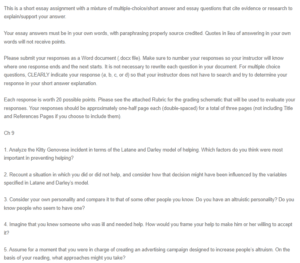Weekly Short Essays – Kitty Genovese Incident and Variables
Question 1: Kitty Genovese incident
According to the Latane and Darley model, the first thing that is supposed to take place so that individuals can help is to take notice of an emergency (Shaver, 2015). Individuals living in a city as big as New York, where it is often noisy and crowded, might not notice when an emergency happens. Therefore, failure to notice the emergency situation that Kitty Genovese was in could explain why she was not helped. The second factor is the interpretation of an emergency. In the case of Kitty, it is possible that the onlookers or people around did not interpret her situation as an emergency, given that they did not have a good handle on the situation.
Furthermore, Kitty might not have received help because of pluralistic ignorance that caused individuals to fail to respond, believing that others had information that they did not, hence the lack of help. The third factor involves diffusion of responsibility, where one assumes that other people will act and hence fail to act themselves (Shaver, 2015). This also explains the bystander effect whereby other peoples’ presence could inhibit one from helping someone in need (Hortensius & de Gelderm 2018). In this case, since there were many individuals near Kitty’s time of need, nobody felt responsible for their actions or, in this case, inaction. Lastly, even though one might have wished to help Kitty, they might not have known how best to do that, given that the helper might get hurt in the process of helping.
Question 2: Variables
While walking on a busy street, it is common to see people’s property snatched by a thief. On one occasion, I saw two men approaching a lady who was just in front of me. The lady was unwary of the fact that her belongings were in danger of being snatched. Together with a few others, we had taken notice of this fact. When the attackers saw that I had taken notice of them, they took a knife and signaled me to be silent. I got scared and failed to alert the lady. The two grabbed her purse and ran away. In this case, I failed to help because I did not know the best way to help the lady, and even if I did, doing so might have endangered her life and mine as well. The concept of diffusion of responsibility could explain the fact that other people had seen the danger that awaited the lady and did nothing.
References
Hortensius, R., & de Gelder, B. (2018). From empathy to apathy: The bystander effect revisited. Current directions in psychological science, 27(4), 249-256.
Shaver, K. G. (2015). Principles of social psychology. Psychology Press.
ORDER A PLAGIARISM-FREE PAPER HERE
We’ll write everything from scratch
Question

Weekly Short Essays
This is a short essay assignment with a mixture of multiple-choice/short answer and essay questions that cite evidence or research to explain/support your answer.
Your essay answers must be in your own words, with paraphrasing properly source credited. Quotes in lieu of answering in your own words will not receive points.
Please submit your responses as a Word document (.docx file). Make sure to number your responses so your instructor will know where one response ends and the next starts. It is not necessary to rewrite each question in your document. For multiple choice questions, CLEARLY indicate your response (a, b, c, or d) so that your instructor does not have to search and try to determine your response in your short answer explanation.
Each response is worth 20 possible points. Please see the attached Rubric for the grading schematic that will be used to evaluate your responses. Your responses should be approximately one-half page each (double-spaced) for a total of three pages (not including Title and References Pages if you choose to include them).
Ch 9
1. Analyze the Kitty Genovese incident in terms of the Latane and Darley model of helping. Which factors do you think were most important in preventing helping?
2. Recount a situation in which you did or did not help, and consider how that decision might have been influenced by the variables specified in Latane and Darley’s model.
3. Consider your own personality and compare it to that of some other people you know. Do you have an altruistic personality? Do you know people who seem to have one?
4. Imagine that you knew someone who was ill and needed help. How would you frame your help to make him or her willing to accept it?
5. Assume for a moment that you were in charge of creating an advertising campaign designed to increase people’s altruism. On the basis of your reading, what approaches might you take?

